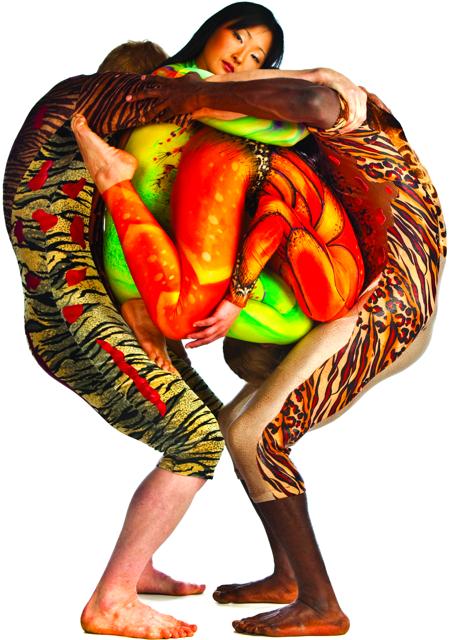It’s fitting that Pilobolus Dance Theatre — an acclaimed contemporary dance company that takes its name from a fungus — draws inspiration from the natural world, exploring both biological themes and the physics of the human from. At times it is absolutely awe inspiring to watch the company in motion: Dancers fold themselves over and around each other — heads are tucked into armpits, legs are wrapped around shoulders and backs — to build a human sculpture on stage. The sculpture then falls, seamlessly, and dancers come back together in yet another stunning amalgamation.
“The metaphor for us is interesting,” says Robby Barnett, an artistic director and founding member of the company, describing how Pilobolus identifies with its name. “Funguses are powerful, they’re outdoorsy and the biological imagery has served us well. We [as a company] need tolerance [and] durability.”
Using elaborate weight-sharing techniques — think acrobatic-yoga meets contemporary dance and contortionism — the company has charted new territory in partner dancing, earning an international reputation for its complex, innovative and thought-provoking style. When the company is in action, dancers seem to fit together perfectly, like DNA molecules in flux but linked, working as one and for the benefit of the greater whole.
Founded in 1971 by Barnett and by fellow Dartmouth students of dance, Lee Harris, Moses Pendleton and Jonathan Wolken, the company distinguished itself immediately, functioning as a collaborative artistic collective. Dancers and choreographers work together, through improvisation, to generate physical material. From that process, themes, stories and emotions emerge.
“The physical techniques of the company grow out of our commitment to group activity,” Barnett explains. “It’s an abstract expressionism in which the work itself reflects the gesture of the creative process. When you get a group of people moving together, it’s inevitable that [they’re] going to end up in each others’ arms; and when you touch somebody it says something about how you feel about them, as well as providing a springboard for physical imagination. Those mirrored worlds of psychology and physics have supported us.”
The ultimate goal, as Barnett emphasizes, is to create a group vision without losing the idiosyncrasies of the people who are in that group. “We have refined a system that allows us to utilize the power of groups working together to think creatively, with a system of decision-making that lets us move forward and actually get things done within a certain period of time.”
More significant than the physical techniques themselves, however, is the company’s mission to apply these teachings in and outside of a dance studio. “We’ve come to believe that many problems can be solved by a refinement of certain collaborative techniques, which really becomes a model for civil society.”
Establishing a forum in which to share these insights, the company created The Pilobolus Institute, an educational outreach program that works with elementary schools, non-dancers, college students and people of all walks of life. For the past 15 years, the institute has led an after-school program in the New Haven public school system working with sixth-, seventh- and eighth-grade boys.
“It’s incredible to see 20 hyperactive seventh-graders just stand there, put their arms around each other and do these incredible things,” says Barnett. “They learn something about movement, but they also learn about civil behavior. They empower themselves, learn the power of silence and quiet, the power of listening and they learn to present themselves physically.” Barnett stresses that the company is not interested in teaching people how to move, but how to locate a physical vocabulary of their own.
At Pilobolus’ upcoming show, the company will showcase six dances in two parts. It opens with “Redline,” a high-energy piece that, according to pilobolus.com, “examines the beauty and futility of physical battle.” Next up is a piece called “Transformation,” an excerpt from a full-length work that uses the illusion of projected shadow. To close the first part of the concert, Pilobolus presents a men’s quartet that was originally choreographed in the late 1990s called “Gnomen.”
The female counterpart of “Gnomen,” a piece titled “Duet,” opens the second half of the concert, which is followed by “Walklyndon.” Barnett describes “Walklyndon” as “Pilobolus’ oldest work other than the eponymous ‘Pilobolus,’ made in a squash court in Lyndonville, Vt. in 1971.” The concert ends with “Rushes,” the first of the company’s international collaborations, which was created with two Israeli choreographers, Inbal Pinto and Avshalom Pollak.
The details may seem disparate, but the program is unified by an idea. “There is really one theme in Pilobolus,” Barnett says. “[It’s about] how individuals maintain identity within groups. We’ve been looking at that from one direction or another for the past 40 years.”
— Aiyanna Sezak-Blatt can be reached at asezakblatt@mountainx.com.
who: Pilobolus Dance Theatre
what: A concert of contemporary dance
where: Diana Wortham Theatre, 2 S. Pack Square
when: Friday, Jan. 21 & Saturday, Jan. 22, 8 p.m. ($45 adults/$40 students/$12 children. Info: dwtheatre.com or 257-4530)



Before you comment
The comments section is here to provide a platform for civil dialogue on the issues we face together as a local community. Xpress is committed to offering this platform for all voices, but when the tone of the discussion gets nasty or strays off topic, we believe many people choose not to participate. Xpress editors are determined to moderate comments to ensure a constructive interchange is maintained. All comments judged not to be in keeping with the spirit of civil discourse will be removed and repeat violators will be banned. See here for our terms of service. Thank you for being part of this effort to promote respectful discussion.